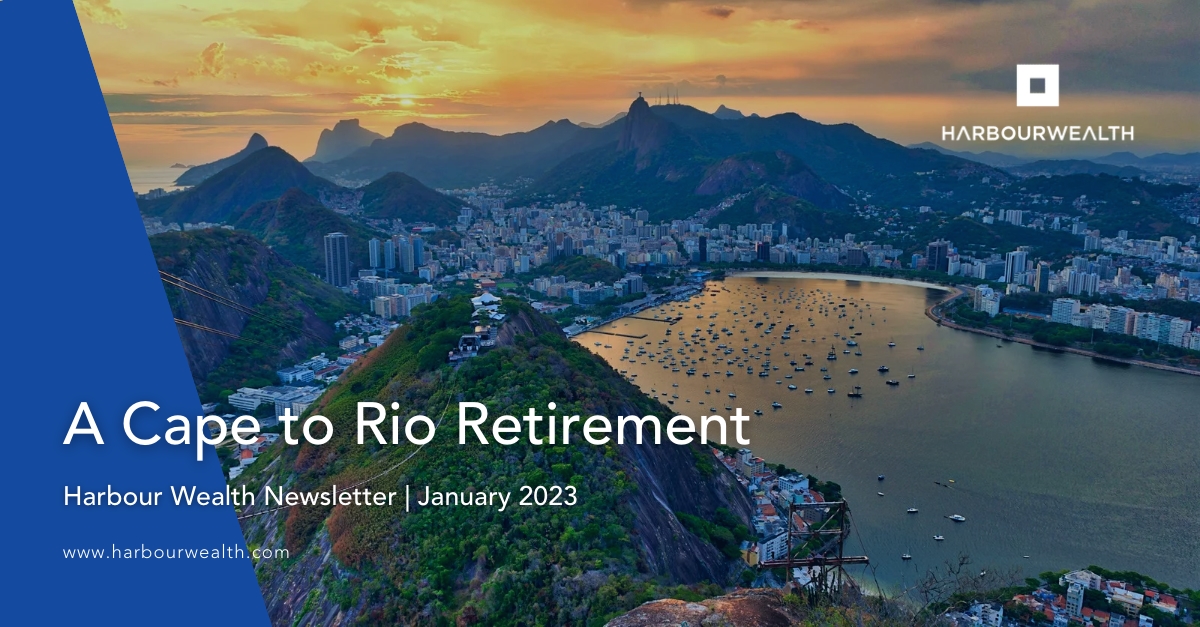The fiftieth Cape to Rio Yacht race is currently under way, 3 300 nautical miles across the Atlantic. There are sixteen teams competing this year, with a healthy South African contingent it should be added. There are yacht races that cover far greater distances (40 000 mile/ 64 000 Km), differing in the variations of rules and equipment allowed, but no different in the skills and bravery required to partake.
It struck me how events such as these, particularly to the average landlubber, seem like outright insanity. There are so many different risks that one may need to deal with, just to survive, let alone win the race.
It is not too dissimilar to each of our retirement/ investment voyages. Fortunately, should fate or fault force a team to retire from a yacht race, they can return home and regroup for the next race.
When it comes to your retirement voyage, withdrawing is never an option, as this is a race that must be finished, irrespective of the time taken or the “Retirement Rio” being sought.
The main goal is to avoid capsizing during inclement weather, steadying, and readying the boat for when the clouds clear, ocean flattens, and manageable winds return. The investment ocean is not kind to fair weather sailors. Fortunately for our seamen, it is easier to predict the weather systems than it is global financial systems nowadays.
1. Selecting the Crew
When it comes to a “finish at all costs” race – your “Retirement Rio” being one of them – only the best crew should be drafted, as it is not only critical to the success of the race but your own survival. There are races where skippers sail alone, but they are a rare breed who have dedicated their life to mastering their skill and the high seas.
For the rest, they will need to have a reliable boat and attract a skilled crew of yachtsmen. This allows the skipper to concentrate his or her efforts on safely directing the yacht to its destination, leaving their team to concentrate on all the other functions that are essential to a successful race.
Our clients are the “skippers” of their boats, determining their own versions of “Retirement Rio”, having the final say on the direction and speed of the race. We fill the key role of “first mate”.
A “first mate” or “first officer” is second in rank to the captain aboard a ship. There needs to be a high level of trust between the two, as the first mate plays the role of watch stander and oversees the boat’s cargo and crew.
The better the first mate is at rallying the right crew and organising each key element of the boat, the safer and steadier the race will be.
2. Building the Boat
There are several important components to a successful yacht with the essential elements as follows:
1. Hull
2. Keel
3. Mast
4. Sails
5. Rudder
2.1 Hull
The hull of a boat is the frame or body of the vessel. It is principally there to protect the occupants, cargo, and equipment. The shape of the hull becomes important when racing as it can improve or detract from performance.
On your retirement voyage, the hull is representative of the financial advice you receive. The hull must be purpose built, taking into consideration both the size and weight of the cargo as well as the journey that must be undertaken.
There are constant improvements being made to modern sailing hulls, but as with anything, there are longstanding designs that are tried and tested on the high seas. Remember, in our journey towards a “Rio Retirement”, the goal is to stay afloat and keep trickling forward, irrespective of the weather that we may encounter along the way.
2.2 Keel
The keel is that long protrusion that sticks out from under the hull of a yacht. When on land with that protrusion, they really do seem like fish out of water, but once submerged, the keel plays a critical role. The keel keeps the yacht upright as it contains the ballast, it also prevents the boat from moving sideways in strong wind.
Diversification can best be described as your investment keel. Diversification across multiple asset classes, institutions, and geographical locations, ensures the boat always lands the right way up, regardless of the weather it may need to endure.
Strategically diversifying across several thousand underlying global institutions, guarantees the boat remains steady, should an underlying company ever go bang, or spring a leak – (Steinhoff, Tongaat, African Bank et al in SA alone).
2.3 Mast
The mast is connected to the hull and is the conduit between the yacht and the sails. It also stores important electronics these days, crucial to navigation.
Strategic asset allocation represents the mast on your yacht on voyage to a “Rio Retirement”. It holds the sails, which in turn harness the available wind, moving the hull forward. The type of mast used, would be determined by the weight of the boat, comprised of its cargo and crew. It must also be suited to the number and size of the sails required to propel the yacht forwards.
In favourable conditions, multiple sails can be deployed to harness all the available wind power, only to be quickly furled (rolled away) in bad weather environments. The mast can either make or break the boat.
2.4 Sails
These are critical elements to any sailing boat. Modern day sails are made from strong, durable, and light compounds.
Sails are just like the underlying investments that you hold. They must be suitable to the size of each boat, strong enough to ensure the journey across the Atlantic and light enough that they do not add drag to the yacht.
The investment mix for one boat is different to the next – there is no such thing as one size fits all. The strength of your sails is found in the health of the institutions into which you invest. High fees add significant weight to the sails, which increases drag on your boat and slows progress to Rio.
2.5 Rudder
Hopefully the rudder needs no introduction to our readers. The rudder is the primary control surface used to steer a boat. If the rudder does not change direction and remains locked off centre, the boat will only go around in circles.
The rudder is representative of our client and their respective objectives in life. These objectives, unique to each client, determine the direction and nature of the journey for the yacht and its team.
The rudder may temporarily veer off course for an emergency, or to pick up and (eventually) drop off precious cargo (children) along the way, but it must ultimately recalibrate and redirect itself towards Rio.
Conclusion
It is imperative that we always remain in the race towards our version of a “Rio Retirement”. We have no control over the prevailing weather systems and storms are a certainty along the way. If your boat were to capsize or you retire from the race, you cannot catch those who remained invested throughout the voyage – those brave few who were ready to harness the good weather that follows every storm. By the time you get your boat and crew back in the water, the winds have moved South, and you have fallen even further behind.
While there are key components to any sailing boat, she is only as good as the crew that sails her. If the management of the boat and all its parts are not aligned with the outcomes of the captain, Siberia may become your new destination. 2022 was stormy year in global markets, the worst on record since 2008. 2023 has shown promising improvements in the weather, but risks remain. When last did you refurb your boat, assess your crew or confirm your course.



